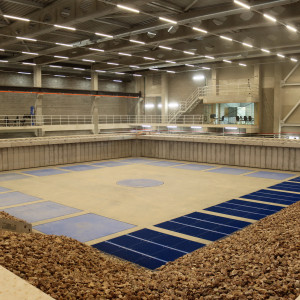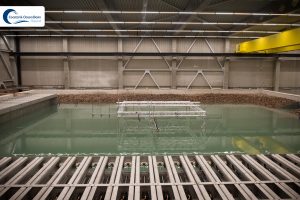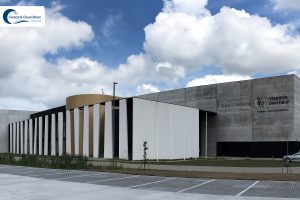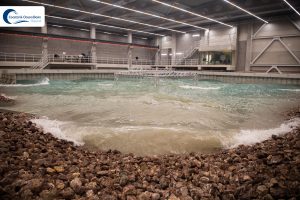Coastal & Ocean Basin
TA84 – UCC-UNIGhent-COB
Location
Wetenschapspark 8
900 Ghent, Belgium

Description
The Coastal & Ocean Basin (COB) facility, located in the Flanders Maritime Laboratory on the Ostend Science Park, accommodates industrial and academic driven testing of offshore renewable energy technologies, as well as coastal and offshore engineering scale models in Belgium. The COB is a state-of-the-art wave and current tank, composed of a large concrete structure (30m x 30m x 2.3m – L x W x H) filled with water in which high-quality waves and currents are generated in a controlled manner using advanced generator systems.
The COB and its associated testing services have been designed in order to facilitate the needs of the offshore renewable energy, as well as coastal and offshore engineering community. Dikes, harbours, breakwaters, offshore (floating) wind turbines, wave energy converters and other coastal and offshore structures are currently installed globally. To guarantee optimal performance in extreme hydrodynamic conditions at sea, the operation ability and survival capabilities of the structure need to be tested using a scaled representation of the prototype in the COB. The scale models are installed in the wave basin and their design and behaviour is studied in the measurement area with high-quality waves and currents. The COB has been designed with a number of unique features, such as the ability to generate waves and currents at any relative angle. Extreme directional wave conditions with a wave height up until 0.55m can be generated together with current velocities up to 0.4 m/s. Additionally a sediment bed can be installed to model correctly the interaction of structural elements with the soil.
The Coastal & Ocean Basin Ostend is managed by a consortium composed of Ghent University, KU Leuven and Flanders Hydraulics Research, and is supported by a number of strategic key partners in the Belgian offshore renewable energy sector, as well as coastal and offshore engineering community and is member of the MARINERG-i_PP project.
Testing Capabilities
The COB is operational since March 2023. Since then, various project have been executed, for example, featuring testing of wave energy converter arrays, study of the hydrodynamic behaviour of floating PV structures, wave diffraction and scour protection around offshore wind monopiles. Similarly, COB anticipates to conduct future testing services for the offshore renewable energy sector, by studying the hydrodynamic behaviour of floating technologies subjected to wave and current loading. Anchoring solutions, mooring line behaviour or trenching of cables under wave and current loading can be tested as well, potentially adding a sediment bed for correct modelling of the structure-soil interactions. The following key technologies are identified for experimental testing in COB using waves, currents and sediment:
- Wave energy converters
- Offshore floating wind structures
- Offshore fixed wind structures
- Floating PV structures
- Tidal turbines
- Anchoring and mooring applications
- Cable trenching
Technical Equipment
A summary of features and key characteristics of the Coastal & Ocean Basin (COB) are given below:
- Basin dimensions: 30 m x 30 m x 2.3 m (L x W x H)
- Maximum water depth: 1.4 m
- Maximum wave height: 0.55 m
- Wavemaker: L-shaped piston type wavemaker to generate regular, irregular, short-crested and directional waves of 1st and 2nd order, with active absorption
- Maximum current velocity: 0.4 m/s
- Current generator: Propeller induced current velocity profiles. Turbulence damped to intensities below 10%
- Portal crane 6 t
- Forklift truck 1.5 t
To measure accurately the modelled processes, the following measurement portfolio is a available at the COB:
- 10 Fix Qualisys motion capturing cameras
- 6 Mobile Qualisys motion capturing cameras
- 4 Underwater Qualisys motion capturing cameras
- 30 Resistive type VTI wave gauges of 0.7 m length
- 6 ADV Nortek Vectrinos
- Compression and strain gauge type load cells
- Piezo-electric pressure sensors 1 bar
- Wave run-up measurements
- Video and Digital camera images
- Faro laser scanner
- Flexlogger National Instruments DAQ system
Additional information
Technology Readiness Level: 1-3
Special considerations: N/A
Technology clusters: Ocean Energy, Offshore Wind, PV
Availability: All year
Provision of tools to prepare data sets in a FAIR way: Yes



